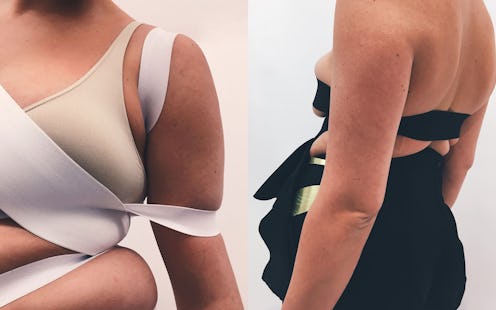Fashion
This Clothing Line Accentuates & Celebrates Body Rolls & Bulges

Squish, plop, bulge. These are the negative words that might pop up when you look at your tummy rolls, your back bulges, or your pancake thighs on a seat. But Brazilian fashion designer Karoline Vitto finds beauty in the little rolls women were always told to hide. In her new graduate collection, which debuted at the Royal College of Art 2019 MA degree show, Vitto launched a line of clothes that accentuated the folds and curves of the female body in order to challenge the status quo.
The collection marched down the catwalk on June 8, and it featured simple cut out slip dresses, bondage-like jumpsuits, and sheer paneled maxis. These clean-cut looks were minimalist in design, but they had small accents — like metal frames or thick bandage straps — that enhanced bulges and rolls. By doing this, Vitto gave a decorative spin to areas that women tend to feel self-conscious about. Even more revolutionary, Vitto used elastics and compressions in her designs because those materials were traditionally used to cinch the body in. But she used them instead to make flesh pop out.
The idea for her collection started percolating years ago, right after she bought a waist clincher. Vitto wasn't very happy with her body at the time, and she hoped the shapewear would help smooth out her silhouette. Instead, the opposite happened.
"The piece was so tight that it took both my mum and sister to help me put it on," Vitto shares with Bustle. "And the result was that, despite having a smaller waist with that piece, some rolls would pop up on my back and some would pop down. And suddenly you see yourself buying a specific type of bra to tuck the back rolls in. And then a compression top to go with that and tummy tucker pants… and it never ends."
Remembering this ordeal, in 2018 Vitto decided to take a series of portraits with the waist clincher. But this time around Vitto purposefully made the flesh pop as a response to society's obsession with hourglass smooth figures.
"I wanted to question why we submit ourselves to constant body modifications, or tight lingerie, or why we body shame ourselves so much, when we could see our bodies as something that could be appreciated by its natural texture, form, or lines," Vitto explains.
This eventually led to her clothing collection, which shines a celebratory spotlight on these little bulges.
"I have never seen back rolls being appreciated as much as cleavage, for example. So I wanted to propose finding beauty in what we tend to see as 'flaws,'" Vitto says.
Each strap and cutout has a significant push-back to a beauty ideal. The elastic strap across the breast, for example, was Vitto's personal response to never finding a bra that really fit her breasts properly.
The underarm bulge decorated with a brass plated ring is meant to be tiny jewelry for your body rolls.
"It's about decorating this area in the same way that you would put a necklace around your neck to frame your face, or a bracelet to decorate the arms. It’s about treating this area as a thing of beauty," Vitto shares.
The dress with a cutout for your underboob is a jab at the beauty industry's claim that perky boobs are the only silhouette to strive for.
"It's my response to push-up bras and how the beauty industry has been pressuring women about having lifted breasts, when the truth is that unless you have breast implants, they will naturally fall…or maybe they are naturally lower because your body was just born like that," Vitto says.
In other designs, she tries to celebrate bulges as much as society celebrates cleavage. Vitto does this by giving both body parts an equal amount of air time.
"I wanted the side roll to have the same visual weight as the amount of flesh revealed in the breast, giving these two areas an equivalent importance," Vitto says. "For that, I framed the side roll in an organic cut-out to balance it out with the amount of breast that was popping out from under the elastics."
Vitto's goal with this new collection is to help inspire people to start perceiving their bodies more kindly, and no longer feel pressured to look a certain way. And it has been working.
"Women with different body types, sizes, and backgrounds have been messaging me to say that they felt somehow represented by what I was doing, and for me that’s the most important thing," Vitto says. "If someone looks in the mirror and doesn’t see their bodies as something to be changed anymore, my role was done. That would make me the happiest."
This article was originally published on